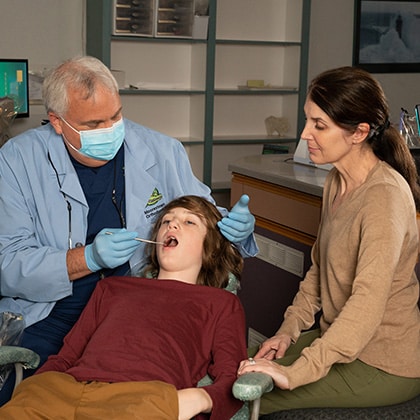If you play a contact sport or participate in an activity for which there is the potential for trauma, we recommend wearing a mouthguard for that activity. The type of mouthguard recommended will depend upon where you are in your dental development and orthodontic treatment. Below are some official recommendations, a description of the types of mouthguards, and our reasoning for recommending certain ones at certain times.
Our experience with sports injuries:
- Baseball, softball, soccer, and cheerleading are sports from which we frequently see dental injuries. This is the result of mouthguards not being required, and not always being worn, for these sports.
- Football, hockey, lacrosse, and field hockey are sports from which we do not frequently see dental injuries. This is because mouthguard wear is required for youth participation in these sports.
Facts from the National Youth Sports Foundation for Safety
Dental injuries are the most common type of orofacial injury sustained during participation in sports. The majority of these dental injuries are preventable.
An athlete is 60 times more likely to sustain damage to the teeth when not wearing a protective mouthguard.
The cost of a fractured or lost tooth is many times greater than the cost of a dentist designed professionally made mouthguard.
Every athlete involved in a contact sport has about a 10% chance per season of an orofacial injury, or a 33%-56% chance during an athletic career.
Facts from the American Dental Association and the California Dental Association:
A properly fitted mouthguard reduces the chances of sustaining a concussion from a blow to the jaw.
Mouthguards should be worn at all times during competition, practice, and games.
The American Dental Association recommends wearing custom mouthguards for the following sports: acrobats, basketball, boxing, field hockey, football, gymnastics, handball, ice hockey, lacrosse, martial arts, racquetball, roller hockey, rugby, shot putting, skateboarding, skiing, skydiving, soccer, squash, surfing, volleyball, water polo, weightlifting, and wrestling.
Once your orthodontic treatment and all needed dental work is complete, the type of mouthguard we recommend is a Custom Pressure Laminated Mouthguard.
Types of Mouthguards
- Off the shelf
- Boil and bite
- Custom vacuum formed
- Custom pressure laminated.
Of the four, custom pressure laminated is the best. They are the only custom mouth guards to obtain the recommended 3mm of thickness outside the upper front teeth. Having a custom mouthguard that is fitted by a dental professional also helps provide greater protection against concussions. These mouthguards are available for patients who have completed their orthodontic treatment and all needed dental work.
Custom Pressure Laminated Mouthguards are the only custom mouthguards that we fabricate. Our office uses the Drufomat pressure-forming machine. It is one of only two machines made that will laminate the mouthguard material and can thereby obtain the recommended 3mm of thickness outside the upper front teeth. Fabricating mouthguards in house has allowed us to offer them at a significantly decreased cost for our patients. If your child’s treatment is complete, they participate in an activity with the possibility of trauma, and you are interested in the protection of a custom mouthguard, please let us know. You have invested a great deal in your smile. A custom pressure laminated mouthguard helps to protect that smile.
Mouthguards During Orthodontic Treatment:
During orthodontic treatment, the teeth are constantly moving. So a true custom mouthguard cannot be fabricated. It would either fit too well, and stop the teeth from moving, or it would cease to fit after the teeth have moved. Likewise, boil and bite mouthguards can have the same drawbacks. They fit well enough to stop or hinder orthodontic tooth movement. As a result, during orthodontic treatment we recommend the use of an “orthodontic mouthguard”. Fortunately, we will provide one for you as a part of your treatment. We have them in a variety of colors, with and without facemask straps. Just let us know that you need one while you are in for your appointment.
Mouthguards for Children:
Technically, a custom mouthguard can be fabricated for a child patient who is not yet in orthodontic treatment. However, there are some drawbacks. The first is the cost of a custom mouthguard and the limited time that it will fit. The loss of primary/baby teeth and the eruption of permanent teeth can cause a previously made custom mouthguard not to fit. Likewise, once orthodontic treatment is initiated it will no longer fit. As a result, for patients in this age group, a boil and bite mouthguard is the solution that is frequently chosen. These can frequently be purchased very cost effectively at a sporting goods store. When the patient loses baby teeth or permanent teeth erupt, the mouthguard can be readapted or a new one can be adapted.
Warnings about the fit of a custom mouthguard: A custom pressure laminated mouthguard is truly a custom item. Any changes in the patient’s teeth may cause the mouthguard not to fit. Teeth shifting due to inadequate retainer wear or having significant restorative work with your general dentist could cause the mouthguard not to fit and a new one to be needed. Please allow 2 weeks for appliance fabrication. The patient must be present for insertion of the mouthguard as some customizations take place at that appointment.
More Information: If you would like more information, we recommend referencing SportsDentistry.com and SportsDentistry.com/mouthguards






